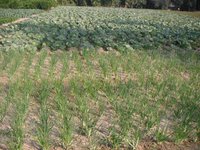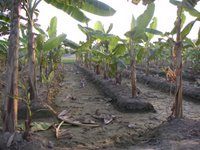[This is a copy of an email Dan Palmer sent to the permaculture oceania listserv January 9 2006 - the posts above contain the photos referred to in this post]
Dear all,
I write from a village in rural Kolkata where I have come to run a permaculture project for about five weeks. I only just did my PDC a few months ago with Bill and Geoff in Melbourne so am sort of figuring it all out as I go along. I am working with an organisation called ISW (the Institute of Social Work) which among other things coordinates over 100 self-help groups with a combined membership of around 3000 poor village women and with micro-credit schemes and various other invisible structures and programs ( e.g., vocational training, daycare, a spice grinding and preserve making business) already in place. Many of these women are very keen to learn about and apply permaculture ideas and I will be here for at least another 2-3 weeks helping to establish demonstration gardens at two sites.
Along with an abundance of resources such as food scraps, azolla, shredded sugar cane residue, coconut husks, and used banana leaf plates, there are endless quantities of labour and enthusiasm on the part of the women. It is a very flat landscape, the soil is humus-free grey clay (quite alkaline where we have tested) and the water table is high – even in the middle of the dry season there are ponds and trenches full of water everywhere.
I was lucky to find a fellow able to translate brochures on chicken tractors, banana circles, and fast compost into Bengali, and we have now had a successful day of theory (including Roland Bunches' principles of sustainable tropical agriculture). Practice-wise we have done some mulching and seed-planting (with thanks to Alf from Eden Seeds for the seeds they generously donated), put down a hot compost, dug and mulched a greywater-fed banana circle, and before the week is out we will begin a herb spiral, a bamboo chook-tractor, and a manadala no-dig garden.
Getting some mulching happening here is definitely a priority – the greenest plants around are the azolla clogging up the waterways – best get that nitrogen to work! (I am actually staying at a boy's home and each morning a bunch of boys come down to the pond and we fill about 3 sacks). Now, although I can somewhat tentatively say things appear to be under control (in a very Indian sort of way), I had a few questions and thought I'd fire them off to you lot on the off chance someone can help answer them (privately if you like at darnample@gmail.com so we don't clog up this list-serv):
(1) I am thinking off putting in a mandala garden around a large mango tree along the lines of p. 274 of the designer's manual. The area below the mango still receives some direct light and the canopy is relatively thin. I figure the mango will be a boon in the hot wet monsoon season (where the ground is apparently submerged under about 20cm of water for three months), providing both shade and slowing down the heavy rains a bit. My only concern really is whether the root system of a mature mango will steal all the nutrients that I intend to go to the garden (though I guess those nutrients will be going to a good cause...). I have posted photos of the site to a new blog at http://permacultureinindia.blogspot.com/, and I would love your input or comments and suggestions for species and layout. I am also wondering how high above the moonsoon high-tide mark I should raise the beds and what to edge those beds with given they will be curved. For the living weed barrier I have sourced lemon grass and hope to have some comfrey (which I haven't yet seen here) seeds sent over.
(2) I haven't seen Kang Kong growing or at the markets in this area but am sure it would grow very well. My only concern in having some seed sent over is that it might become invasive. Does anyone have any thoughts on this? the most common plant here next to coconut and banana, by the way, is something that looks a lot like Taro (in Bengali it's called "Gochu").
(3) I want to introduce the idea of interspersing nitrogen fixing mulch and fodder plants with other crops to improve what is generally bare hard and humus-free clay (some of the women are working large plots of land and I think this could improve their yields). I've seen a number of different tree candidates around but the locals can of course only give me the Bengali name. See http://permacultureinindia.blogspot.com/ for photos. I am hoping some of you familiar with tropical nitrogen-fixing trees and shrubs could send me an email with the names of those you recognise. I can't wait to figure out which one is Leucaena. This goes also for a couple of species of living fence options I've seen. I want to select the best one for fencing in a chook-tractor (in Bengali: "Murgi-Tractor") based garden we will build tomorrow. I know that one option is the magical Neem tree (which is of course abundant here) and I wonder if anyone has any thoughts on that or on the relative merits of living vs dead (bamboo) fences.
(4) Does anyone have an email or phone number for the permaculture demonstration site of the Deccan Development Society in Pastapur near Hyderabad (with one Mr Venkat)? I may have a chance to visit and bring ideas and techniques back to this project.
(5) We want to attempt a herb spiral which I don't see listed in the manual's index – can anyone email me details or maybe a digital photo (or scanned or ocr'd page) of an article including specifications and particularly what herbs to put where? Coriander is the local favorite by a long shot (and cauliflower the most popular vegetable along with red onions and I haven't seen a single normal onion!).
(6) A fellow yesterday dragged me over to show me his coconut tree which had some afflication meaning it wasn't producing fruit. He wanted to know what was wrong, saying it was becomoing a widespread problem in West Bengal. I took a photo (see http://permacultureinindia.blogspot.com/) and if anyone knows what deficiency or disease it is and what can be done about it this information would be very well received.
(7) Finally, if anyone has any printed information, books, photos, or seeds they think might be helpful based on what I've said here and are in a position to post over here (ideally to arrive before January 26), myself and up to 3000 Indian women (some of which do speak and read English) would be eternally grateful. I am making a little movie about the project and would be happy to send you a copy by way of a thank you. Here is the address:
Dan Palmer/Permaculture Project
c/o Nupur Sanyal
Institute of Social Work
29B, Chetla Central Road
Kolkata – 700027
IndiaThanks in advance for any guidance you can offer and I was thinking that anyone else doing permaculture stuff in India would be welcome to use the blog - over time it could become a resource for folks coming here in future.
Dan Palmer
ps. Rick – I haven't got sick yet ;-), and David – those permaculture-in-India articles I copied from your back issues have been invaluable!







